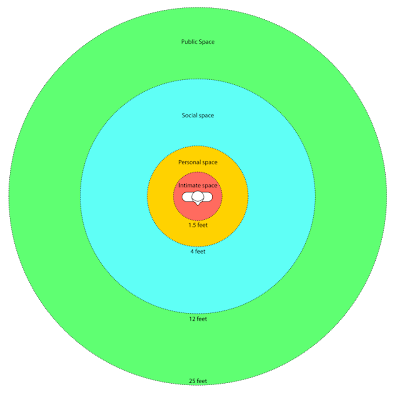 |
| Diagram of Edward T. Hall's personal reaction bubbles (1966), showing radius in feet |
Personal space is the region surrounding a person which they regard as psychologically theirs. Invasion of personal space often leads to discomfort, anger, or anxiety on the part of the victim.
The notion of personal space comes from Edward T. Hall, whose ideas were influenced by Heini Hediger's studies of behavior of zoo animals.
The amygdala is suspected of processing people's strong reactions to personal space violations since these are absent in those in which it is damaged and it is activated when people are physically close.
Size
A person's personal space (and corresponding comfort zone) is highly variable and difficult to measure accurately. Estimates place it at about 60 centimeters (24 in) on either side, 70 centimeters (28 in) in front and 40 centimeters (16 in) behind for an average westerner.
Variation
 |
| Two people not affecting each other's personal space |
 |
| Reaction of two people whose personal space are in conflict |
Personal space is highly variable. Those living in a densely populated places tend to have a smaller personal space. Residents of India tend to have a smaller personal space than those in the Mongolian steppe, both in regard to home and individual. For a more detailed example, see Body contact and personal space in the United States.
Personal space has changed historically together with the boundaries of public and private in European culture since the Roman Empire. This topic have been explored in A History of Private Life, under the general editorship of Philippe Ariès and Georges Duby, published in English by the Belknap Press.
Personal space is also affected by a person's position in society with more affluent individuals demanding a larger personal space.
People make exceptions to, and modify their space requirements. For instance in romantic encounters the stress from allowing closer personal space distances can be reinterpreted into emotional fervor. In addition, a number of relationships may allow for personal space to be modified and these include familial ties, romantic partners, friendships and close acquaintances where a greater degree of trust and knowledge of a person allows personal space to be modified.
Adaptation
According to the psychologist Robert Sommer a method of dealing with violated personal space is dehumanization. He argues that (for example) on the subway, crowded people often imagine those intruding on their personal space as inanimate. Behavior is another method: a person attempting to talk to someone can often cause situations where one person steps forward to enter what they perceive as a conversational distance, and the person they are talking can step back to restore their personal space.
Neuropsychological space
Neuropsychology describes personal space in terms of kinds of 'near-ness' to the body.
1. Extrapersonal Space: The space that occurs outside the reach of an individual.
2. Peripersonal Space: The space within reach of any limb of an individual. Thus to be 'within-arm's length' is to be within one's peripersonal space.
3. Pericutaneous Space: The space just outside our bodies but which might be near to touching it. Visual-tactile perceptive fields overlap in processing this space so that, for example, an individual might see a feather as not touching their skin but still feel the inklings of being tickled when it hovers just above their hand.
Amygdala
Research links the amygdala with emotional reactions to proximity to other people. First, it is activated by such proximity, and second, in those with complete bilateral damage to their amygdala lack a sense of personal space boundary. As the researchers have noted: "Our findings suggest that the amygdala may mediate the repulsive force that helps to maintain a minimum distance between people. Further, our findings are consistent with those in monkeys with bilateral amygdala lesions, who stay within closer proximity to other monkeys or people, an effect we suggest arises from the absence of strong emotional responses to personal space violation."









0 comments:
Post a Comment